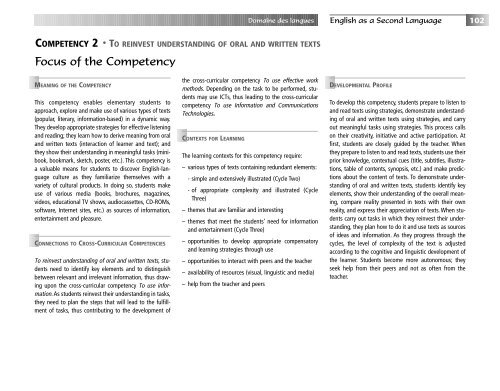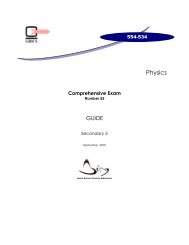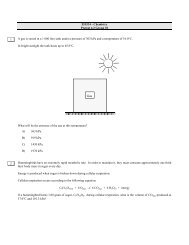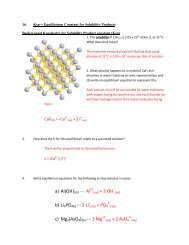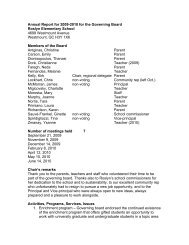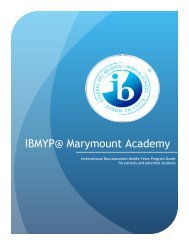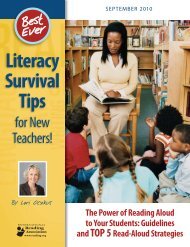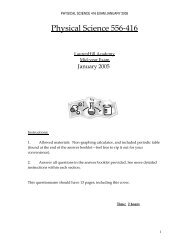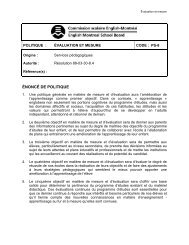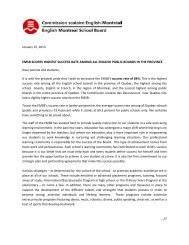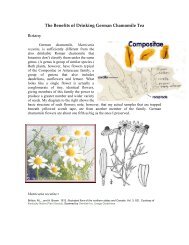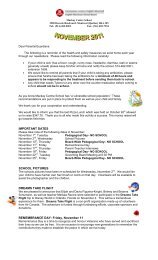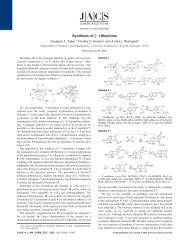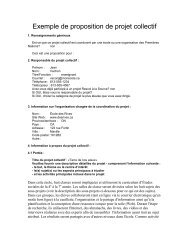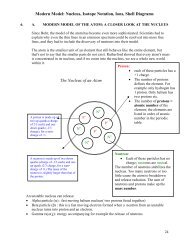Programme de formation de l'école québécoise - Version approuvée
Programme de formation de l'école québécoise - Version approuvée
Programme de formation de l'école québécoise - Version approuvée
You also want an ePaper? Increase the reach of your titles
YUMPU automatically turns print PDFs into web optimized ePapers that Google loves.
Domaine <strong>de</strong>s langues<br />
English as a Second Language 102<br />
COMPETENCY 2 • TO REINVEST UNDERSTANDING OF ORAL AND WRITTEN TEXTS<br />
Focus of the Competency<br />
MEANING OF THE COMPETENCY<br />
This competency enables elementary stu<strong>de</strong>nts to<br />
approach, explore and make use of various types of texts<br />
(popular, literary, in<strong>formation</strong>-based) in a dynamic way.<br />
They <strong>de</strong>velop appropriate strategies for effective listening<br />
and reading; they learn how to <strong>de</strong>rive meaning from oral<br />
and written texts (interaction of learner and text); and<br />
they show their un<strong>de</strong>rstanding in meaningful tasks (minibook,<br />
bookmark, sketch, poster, etc.). This competency is<br />
a valuable means for stu<strong>de</strong>nts to discover English-language<br />
culture as they familiarize themselves with a<br />
variety of cultural products. In doing so, stu<strong>de</strong>nts make<br />
use of various media (books, brochures, magazines,<br />
vi<strong>de</strong>os, educational TV shows, audiocassettes, CD-ROMs,<br />
software, Internet sites, etc.) as sources of in<strong>formation</strong>,<br />
entertainment and pleasure.<br />
CONNECTIONS TO CROSS-CURRICULAR COMPETENCIES<br />
To reinvest un<strong>de</strong>rstanding of oral and written texts, stu<strong>de</strong>nts<br />
need to i<strong>de</strong>ntify key elements and to distinguish<br />
between relevant and irrelevant in<strong>formation</strong>, thus drawing<br />
upon the cross-curricular competency To use in<strong>formation</strong>.<br />
As stu<strong>de</strong>nts reinvest their un<strong>de</strong>rstanding in tasks,<br />
they need to plan the steps that will lead to the fulfillment<br />
of tasks, thus contributing to the <strong>de</strong>velopment of<br />
the cross-curricular competency To use effective work<br />
methods. Depending on the task to be performed, stu<strong>de</strong>nts<br />
may use ICTs, thus leading to the cross-curricular<br />
competency To use In<strong>formation</strong> and Communications<br />
Technologies.<br />
CONTEXTS FOR LEARNING<br />
The learning contexts for this competency require:<br />
–various types of texts containing redundant elements:<br />
- simple and extensively illustrated (Cycle Two)<br />
- of appropriate complexity and illustrated (Cycle<br />
Three)<br />
– themes that are familiar and interesting<br />
– themes that meet the stu<strong>de</strong>nts’ need for in<strong>formation</strong><br />
and entertainment (Cycle Three)<br />
– opportunities to <strong>de</strong>velop appropriate compensatory<br />
and learning strategies through use<br />
– opportunities to interact with peers and the teacher<br />
–availability of resources (visual, linguistic and media)<br />
– help from the teacher and peers<br />
DEVELOPMENTAL PROFILE<br />
To <strong>de</strong>velop this competency, stu<strong>de</strong>nts prepare to listen to<br />
and read texts using strategies, <strong>de</strong>monstrate un<strong>de</strong>rstanding<br />
of oral and written texts using strategies, and carry<br />
out meaningful tasks using strategies. This process calls<br />
on their creativity, initiative and active participation. At<br />
first, stu<strong>de</strong>nts are closely gui<strong>de</strong>d by the teacher. When<br />
they prepare to listen to and read texts, stu<strong>de</strong>nts use their<br />
prior knowledge, contextual cues (title, subtitles, illustrations,<br />
table of contents, synopsis, etc.) and make predictions<br />
about the content of texts. To <strong>de</strong>monstrate un<strong>de</strong>rstanding<br />
of oral and written texts, stu<strong>de</strong>nts i<strong>de</strong>ntify key<br />
elements, show their un<strong>de</strong>rstanding of the overall meaning,<br />
compare reality presented in texts with their own<br />
reality, and express their appreciation of texts. When stu<strong>de</strong>nts<br />
carry out tasks in which they reinvest their un<strong>de</strong>rstanding,<br />
they plan how to do it and use texts as sources<br />
of i<strong>de</strong>as and in<strong>formation</strong>. As they progress through the<br />
cycles, the level of complexity of the text is adjusted<br />
according to the cognitive and linguistic <strong>de</strong>velopment of<br />
the learner. Stu<strong>de</strong>nts become more autonomous; they<br />
seek help from their peers and not as often from the<br />
teacher.


